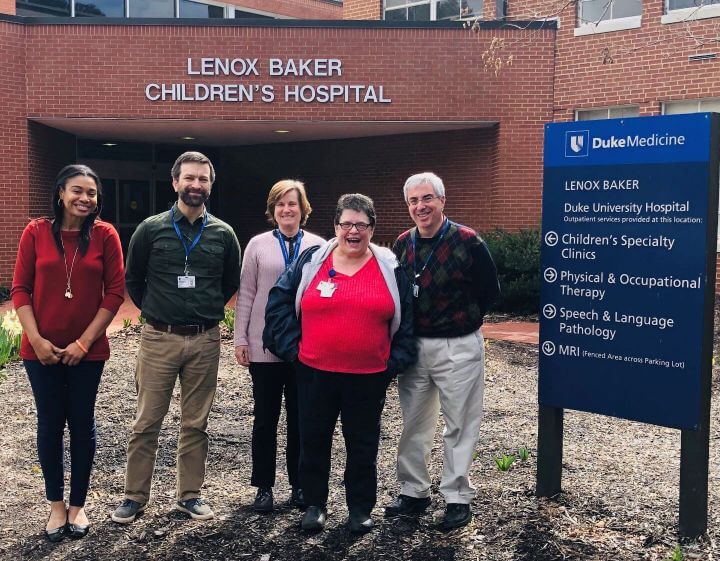Florence Rage, PhD, was awarded $150,000 for her research project, “Deciphering the Mechanisms of RNA Transport along Axons to Understand the Progression of Spinal Muscular Atrophy (SMA).”
Dr. Rage’s basic research grant is one of four awarded by Cure SMA in 2022 totaling $500,000.

Meet Dr. Rage
Tell us about yourself.
I am a neuroscientist working at the Institute of Molecular Genetics of Montpellier in France. After receiving a PhD in neuroscience from the University of Montpellier in 1993, I did postdoctoral training in neuroendocrinology at the University of Portland in Oregon. In 1997, I obtained a permanent position at the French National Center for Scientific Research. Over the years, I have become an expert in understanding the molecular mechanisms of neurodegenerative diseases, with a particular focus on SMN-dependent RNA transport, and local translation along the axon, at the single molecule level.
How did you first become involved with SMA research?
I became involved in SMA research in 2005, when I joined the lab of Rémy Bordonné, an SMA specialist using yeast models to study splicing defects caused by SMN loss. We established neuronal models, including motor neurons derived from human induced pluripotent stem cells (hiPSCs). We also identified RNAs whose localization was disrupted along axons when SMN is depleted, which may cause motor neuron death during disease progression.
What is your current role in SMA research?
My group is currently working on understanding the molecular basis behind the high vulnerability of motor neurons in SMA. We are focusing on a specific role of SMN: mRNA transport along axons. Using molecular tools, we are addressing the question of how the disruption of mRNA transport and local translation along axons could lead to the death of motor neurons and impair neuromuscular junction function in SMA.
What are the project goals?
We would like to develop tools that can establish a link between the regulation of mRNA transport and SMA. We are looking for direct evidence of a connection between mRNA mis-localization and the disruption of neuromuscular junction formation that is observed in SMA.
Proteins are large and complex molecules that provide structure and perform many critical functions in cells throughout the body. Cells must constantly manufacture new proteins to meet the body’s needs, and each gene in our DNA contains instructions for how to manufacture a specific protein. When more of a certain protein is needed, copies of its genetic instructions are made in the cell nucleus in the form of mRNA. The mRNA is then transported out of the nucleus to the part of the cell where more of the protein is needed. There, the mRNA is made or “translated” into the necessary protein.
SMA is caused by recessive genetic mutations in the survival motor neuron 1 gene (SMN1). As a result of these mutations, cells do not make enough SMN protein. The SMN protein is thought to play an important role in the transport of mRNA from the nucleus of motor neurons along their axons. Axons are nerve fibers that carry messages from motor neurons to muscle cells. As such, uninterrupted mRNA transport along the axon is critical to maintaining the synthesis of proteins that are needed to support nerve-muscle communication.
The goal of this project is to study how disrupting mRNA transport affects the function of motor neurons. A gene editing technique called clustered regularly interspaced short palindromic repeats (CRISPR) will be used to disrupt the trafficking of a specific mRNA called ANXA2. The ANXA2 gene encodes the annexin A2 protein, which has important functions in the axons of motor neurons. A variety of techniques will be used to track the transport of ANXA2 mRNA. Finally, we will characterize how the disruption of ANXA2 mRNA impacts motor neuron function.
What will the results tell us?
Understanding how disrupted mRNA trafficking affects motor neuron function may lead to the development of therapeutic strategies that support communication between nerves and muscles, helping to keep the muscle healthy These new SMN-independent treatments may be used alongside existing FDA-approved SMN-dependent treatments to achieve better outcomes for individuals affected by SMA.
Importance of Basic Research
Each year, Cure SMA invites scientists from around the world to submit funding proposals for basic research projects that address specific unanswered questions in SMA biology. Our Scientific Advisory Board ranks the submitted proposals on both their scientific merit and relevance to the Cure SMA research priorities.
This year, Cure SMA’s top basic research priorities include:
- Learning about the roles the survival motor neuron (SMN) protein plays throughout the body.
- Understanding the details of how SMN-dependent therapies work.
- Finding treatment targets other than SMN.
- Combining SMN-dependent therapies and other treatments to achieve the best possible outcomes.
Special thanks to the Nunemaker Family for partnering with Cure SMA in our quest to invest in research that will focus on ways to enhance muscle strength and function as well as investigating nerve muscle connections and the regeneration of nerves. To achieve these goals, the Nunemakers have generously offered to match all gifts up to $250,000. To join the Nunemakers in investing in the future of SMA, please visit this link.



